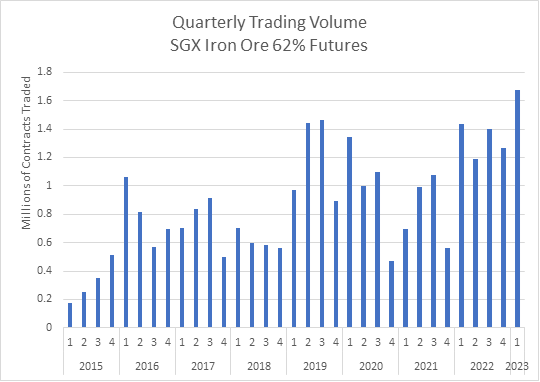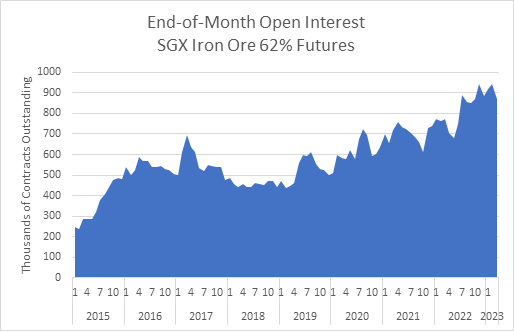Iron ore futures listed on the Singapore Exchange are becoming one of the most important commodity futures contracts in the world.
SGX offers a suite of iron ore futures and options, but most of the activity is in the futures-based on iron ore with 62% iron content, widely used as the benchmark for physical trading.
In 2022, the total number of iron ore 62% futures traded through SGX reached a record 25 million contracts. That was up 38% from the previous year and almost double the level five years ago.
That growth trend is continuing into 2023. In March, 2.9 million of these futures traded on SGX, setting a record for a single month.
Two factors are driving the growth in the trading of this contract.
First, the contract is a hedge for volatility in iron ore prices, and by extension, as a hedge on the pace of economic growth in China. Iron ore is the main ingredient in the production of steel, and the rise of China's steel industry has dramatically altered the pattern of trade with an estimated two-thirds of all seaborne iron ore shipments going to China.
That shift has helped drive greater use of the spot market for pricing shipments of iron ore—and greater need for protection against big swings in prices.
For example, last year's decision by China's government to pivot away from the zero-COVID policy sparked a huge surge in iron ore prices as market participants anticipated renewed demand for steel in manufacturing, real estate and infrastructure. Iron ore prices rose by almost 50% from early November to mid-January, according to commodity strategists at ING.
The second reason for the growth of the contract is the entry of a different set of participants. Historically, the market was dominated by iron ore producers, merchant traders, steel makers and swap dealers with exposures to the underlying physical commodity. More recently, however, hedge funds and other institutions with a purely financial interest have begun using the contract. For this group, the liquidity in the contract has now reached a level sufficient to support their trading strategies.
Open interest, which measures the number of contracts outstanding, is one way to measure liquidity. Like volume, open interest in the main SGX iron ore futures has been rising steadily. At the beginning of 2020, before the Covid-19 pandemic disrupted the global economy, open interest was around 500,000 contracts. So far this year, open interest has been averaging more than 900,000 contracts.
SGX began clearing iron ore swaps more than 10 years ago, at a time when most iron ore was traded bilaterally. In 2013, it introduced iron ore futures, and gradually the market adopted exchange-traded futures. Today, roughly half of the volume is transacted through the exchange's central limit order book, with the rest negotiated off exchange as block trades and submitted to SGX for clearing.
SGX is not alone in the iron ore derivatives market, however. There is a separate iron ore futures market in China, at the Dalian Commodity Exchange. That market is much larger in terms of trading volume, but access from outside China is difficult and much of the trading comes from retail and other non-commercial market participants. In effect, the Dalian and Singapore markets function as two separate pools of liquidity. That creates opportunities for arbitrage between the two markets, providing another driver for trading volume.



